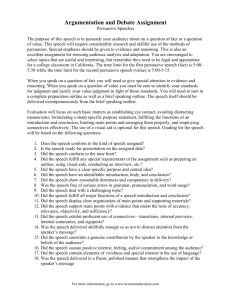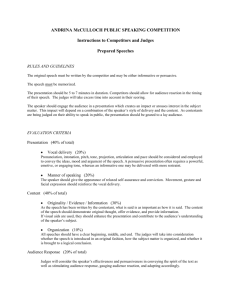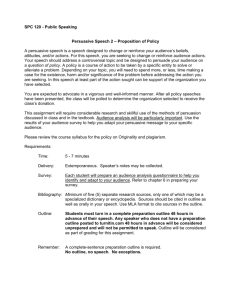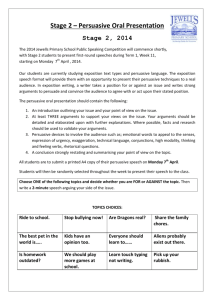Public Speaking - El Camino College
advertisement
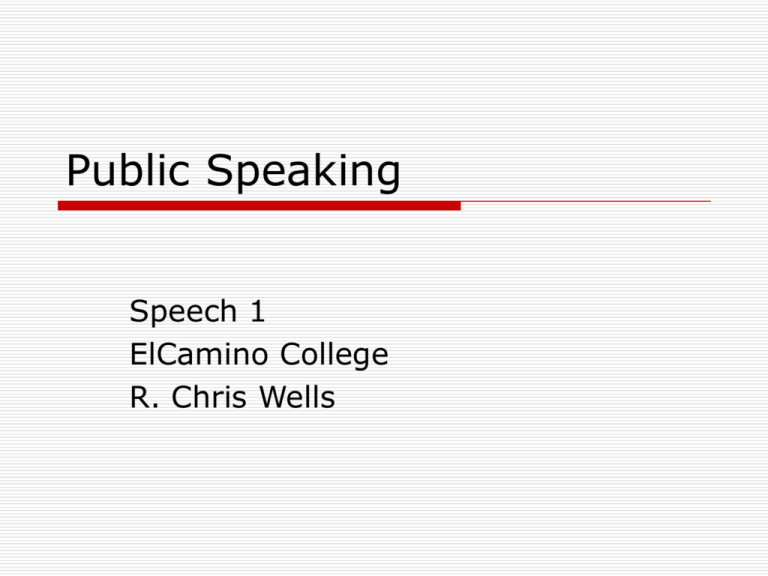
Public Speaking Speech 1 ElCamino College R. Chris Wells El Camino College Statement of Values Our highest value is placed on our students and their educational goals. Interwoven in that value is our recognition that the faculty and staff of El Camino College are the College’s stability, its sources of strength and its driving force. With this in mind our five core values are: _ People We strive to balance the needs of our students, employees and community. _ Respect We work in a spirit of cooperation and collaboration. _ Integrity We act ethically and honestly toward our students, colleagues and community. _ Diversity We recognize and appreciate our similarities and differences. _ Excellence We aspire to deliver quality and excellence in all we do. Attendance Attendance at First Class Students who enroll in class but do not attend the first scheduled class meeting may be dropped from the roster and their places given to waiting students who were unable to enroll at the time of registration. If illness or emergency prevents a student from attending the first class session, the student must contact the instructor. Attendance Attendance Without Official Enrollment Students will not be permitted to attend classes in which they are not enrolled. Exceptions may be allowed by the instructor for bonafide visitors. Students who attend a class without proper enrollment (the student did not property register or add the class) by the published deadline will not be permitted to “late add” the Class except for documented extenuating and mitigating circumstances. Attendance Attendance Without Official Enrollment Students will not be permitted to attend classes in which they are not enrolled. Exceptions may be allowed by the instructor for bonafide visitors. Students who attend a class without proper enrollment (the student did not property register or add the class) by the published deadline will not be permitted to “late add” the Class except for documented extenuating and mitigating circumstances. Attendance Attendance During Semester Regular attendance is expected of every student. A student may be dropped from class when the number of hours absent exceeds the number of units assigned to the course. However, it is ultimately the responsibility of the student to officially drop the class. This rule also applies to excessive absences due to illness or medical treatment. The student who has been absent due to illness or medical appointment must explain the absence directly to the instructor. The student who has been absent due to a communicable disease or quarantine must report directly to the Health Center for clearance before returning to classes. Cheating or Plagiarism The El Camino College faculty, staff and administrators are dedicated to maintaining an optimal learning environment and will not tolerate academic dishonesty. To uphold the academic integrity of the institution, all members of the academic community, faculty and students alike, must assume responsibility for providing an educational environment of the highest standards characterized by a spirit of academic honesty. The following statement is part of Board Policy 5138, Standards of Conduct: “Dishonesty, including but not limited to cheating, plagiarism or knowingly furnishing false information to the college.’’ When there is evidence of cheating or plagiarism in classroom work, students may receive an F for that piece of work or may be suspended from all classes for that term and the following term if deemed appropriate. Examples of Cheating or Plagiarism are: Representing the words, ideas or work of another as one’s own in any academic exercise (plagiarism), including the use of commercial term paper companies; Copying or allowing another student to copy from one’s paper or answer sheet during an examination; Allowing another individual to assume one’s identity for the purpose of enhancing one’s grade in any of the following: testing, field trips or attendance; Falsifying or attempting to falsify attendance records and/or grade rosters; Changing answers on a previously scored test, assignment or experiment with the intent to defraud; Inventing data for the purpose of completing a laboratory experiment or case study analysis with the intent to defraud; Giving and/or taking information during an examination by any means such as sign language, hand signals or secret codes; Obtaining copies of notes, exams or exam questions by any means other than distribution from the instructor. (This includes copying and removing exam questions from the classroom for any purpose.); Using study aids such as calculators, tape recorders or notes that have been specifically prohibited by the instructor. Effective Speaking Speech Communication 1 Instructor: R. Chris Wells Email: rwells@elcamino.edu Office: Music 132A Phone: 310 660-3723 Catalog Description: This course covers the fundamentals of speech communication. Emphasis is placed on organization, evidence, logic, and performance techniques. Students will organize and present speeches based on various topics and applications. Text: Sprague & Stuart, The Speaker's Compact Handbook Course requirements: 1. I believe Speech; 3 to 5 minutes, Evaluated. 0 points. 2. Informative Speech; 5 to 7 minutes, using “The Classical Pattern,” 100 points. 3. Persuasive Speech; 5 to 7 minutes using "Monroe's Motivated Sequence," 100 points. 4. Oral Report; 5 to 7 minutes. Research based article from a current communication journal and one page handout for class, 100 points. 5. "Entertaining" or "Stimulate or Impress," 5 to 7 minutes. 100 points. 6. Cross-Examination Debate; Matched argumentative presentation with Cross-examination. 15 to 20 minutes (2 Speakers). 100 points. 7. Speech Evaluation; written evaluation of outside speakers, see “Post Communication,” 50 points each. Two speakers, 100 points. 8. Final Exam; 100 question objective exam based upon lecture and text. 100 points. Attendance: Five points will be deducted for each class hour missed in which there are student speakers. Students who are absent more than 20% of class hours for any reason will not receive a passing grade in the class. Students are expected to arrive at the time the class begins. Excessive tardiness will also affect grade Other assignments Other assignments at the whim of the instructor to provide pace and understanding of human communication; impromptu speaking opportunities, quiz activities, etc. Up to 100 points. Grading A<=90%> B<=80%,>C<=70%> D=60%>F of possible points. POST COMMUNICATION Criticism and evaluation 1. What kind of speech was it? Deliberative: which refers to political oratory in legislative assemblies? Generally discussing future policy. Forensic: which refers to the kind of speech that occurs in judicial proceedings, as, for example, counsel’s summation to a jury? Generally discussing the facts of the past. Epidictic: which refers to an effort to praise or dispraise something, whether that is a person or a policy. Generally discussing the “here and now.” POST COMMUNICATION Criticism and evaluation 2. Define the demographics (the observable characteristics of the audience) and psychographics (the lifestyles of the audience). POST COMMUNICATION Criticism and evaluation 3. What was the speaker’s perception of the target audience’s attitude toward the speaker’s thesis? Predetermined action for (stimulate or impress speech), predetermined belief for (persuasive speech), predetermined belief against (informative speech), or predetermined action against (entertaining speech)? POST COMMUNICATION Criticism and evaluation 4. Evaluate ethos as demonstrated in the speech. What did the speaker do to demonstrate they are a person of good character? How did they demonstrate their expertise, trustworthiness, dynamism and/or sociability? POST COMMUNICATION Criticism and evaluation 4. Evaluate ethos as demonstrated in the speech. What did the speaker do to demonstrate they are a person of good character? How did they demonstrate their expertise, trustworthiness, dynamism and/or sociability? POST COMMUNICATION Criticism and evaluation 5. Evaluate pathos as demonstrated in the speech. What did the speaker do to cause emotional reactions in the audience? Did they promote fear, anger, sadness, happiness, or other emotions? Was the speaker passionate? POST COMMUNICATION Criticism and evaluation 6. Evaluate logos as demonstrated in the speech. What did the speaker do to demonstrate sound reasoning (inductive and/or deductive)? What type of evidence did they use to support their claims? How did they link claims to evidence? POST COMMUNICATION Criticism and evaluation 7. Evaluate taxis as demonstrated in the speech. How was the speech organized? Why do you think the speaker choose this organizational style? Was it effective? POST COMMUNICATION Criticism and evaluation 8. Evaluate Lexis as demonstrated in the speech. What language did the speaker use to illicit personal semantic reactions? Do you believe that the speaker’s word choice was purposeful and effective? POST COMMUNICATION Criticism and evaluation 9. Contrast the speakers "point of view" to your "point of view." The Classical Pattern Halford Ryan, Classical Communication For the Contemporary Communicator Introduction Cicero held that a convincing introduction would make the audience well disposed, attentive, and teachable. Unlike an introduction for a basic persuasive speech, the classical exordium does not include any adjusting or previewing language. Such adjusting or previewing language would ruin the efficacy of the pattern by divulging its organizational strategy. The Classical Pattern Halford Ryan, Classical Communication For the Contemporary Communicator Narrative In legal oratory, the purpose of the narrative was to tell about the crime, to relate the motives of the accused and defendant, to render the scene, and to dispose the listeners toward the speaker. However, the narrative form is easily transferable to other kinds of speeches. The narrative is a rhetorical story that the speaker constructs so that the audience perceives reality, not necessarily as it was or is, but as the speaker wants it to be. A plaintiff would narrate the crime from his perspective while portraying the defendant in the most unfavorable light. The defendant would talk about the scene from his viewpoint while taking care to malign his adversary as much as possible. Narratives should be real. A story about an actual event can be documented. Conjectural narratives run the risk of being too removed from reality and apparently made up. Narratives should be constructed to portray the speaker or the cause in the most advantageous light. The Classical Pattern Halford Ryan, Classical Communication For the Contemporary Communicator Arguments In the arguments section you marshal the evidence in favor of your proposal. Depending on your time limits, you can generally select three or four proofs to advocate your thesis. Then you develop the arguments as main heads with reasoning and analysis, quotations, and transitional materials to get the audience from main head to main head (e.g., "The major reason for tax incentives is...," "Another ground is...," "And the last justification is as follows ...."). When beginning to write your speech, you will probably have some arguments that you want to present. As you research your topic, you might find additional or better arguments to support your thesis. When you have completed your research, you need to use the arguments, backed by the strongest evidence you could discover, that will best persuade the audience. The Classical Pattern Halford Ryan, Classical Communication For the Contemporary Communicator Refutation After the speaker has presented all of the proofs for the case, he or she then turns the audience's attention to the refutation section. As with the proof, three or four refutations should suffice for most student speeches. The refutation can serve two functions, which can be combined if you desire: 1. You can use the refutation to refute objections that the audience probably has against the proposal or thesis. Here is where you target neutrals and especially opponents. As you conduct the research for your speech, with the primary emphasis on securing evidence for your proposal, you often come across opinions that reflect opponent's arguments against your stance. These positions can form some of the basis for your refutation as you seek additional reasons and evidence to rebut the opposition's s views. 2. You can use the refutation to attack your opponent or the opposition. You should be forewarned that some speakers misuse the refutation to attack adversaries personally. This is called argumentum ad personam, because the speaker attacks the opponent personally rather than the opponent's reasoning and analysis. The idea is that if you can discredit your antagonists, you denigrate their arguments as well... The refutation can also be misused in another fashion. Some speakers combine an attack on opposing arguments with an attack on the opponents. The Classical Pattern Halford Ryan, Classical Communication For the Contemporary Communicator Conclusion Rather than a straight summary, the conclusion functions better as an appeal to action or a charge that the audience changes its beliefs. It strives for a heightened impression to make an outstanding effect. Preparing Persuasive Speeches Monroe's Motivated Sequence I. Attention The functions of the attention are to create interest in the topic and desire to attend to the problem, to establish your credibility and connection to the topic, and to address the audience's psychological states or predispositions to the topic. Preparing Persuasive Speeches Monroe's Motivated Sequence II. Need The purpose of the need step is to create or develop the problem. It is an analysis of what is wrong and how these wrongs affect the individual's interests and desires. In this step you relate your subject to the vital concerns and interests of your audience. The need step should: 1. State need—a clear statement of need or problem 2. Illustrate— use examples that describe the need 3. Elaborate—use additional examples and supporting materials (statistics and testimony) to show extent of need; you must show your audience how this is a severe problem 4. Point—use convincing demonstrations of how the need directly affects the audience's health, happiness, welfare—motivational appeals work well here Preparing Persuasive Speeches Monroe's Motivated Sequence III. Satisfaction The purpose of this statement is to state the proposition (what you want audience to think, believe, or do) that will alleviate the problem and satisfy individuals' interests, wants, desires. In this step you should 1. State the proposition—what you want from the audience 2. Explain your proposal 3. Show how it meets the problem pointed out in the need step 4. Give examples showing how the proposal (your idea) has worked or can work effectively—use facts, figures, and the testimony of experts Preparing Persuasive Speeches Monroe's Motivated Sequence IV. Visualization The function of the visualization step is to intensify desire and seek belief or action from your audience. To accomplish this you need to project into the future and describe the results of your solution (the satisfaction step). The visualization step should describe 1. Vividly what the world would look like and/or feel like if the proposition was believed or followed or 2. What the world would look like if the proposition was not believed or followed. You must state the benefits of the proposition; it is optional to describe the dangers of not accepting the proposition. Preparing Persuasive Speeches Monroe's Motivated Sequence V. Action This step is a final call for commitment or a call to action. As in the conclusion of an informative speech, you should restate the proposition or thesis and end with a clincher-type statement. The action step may use one or more of the following devices: 1. Challenge or appeal 2. Quotation 3. Illustration 4. Summary of Proposition 5. Steps to achieving proposition Grading Criteria for Speech I. Normally, an average speech ("C" grade) should meet the following standards: A. Should conform to the type of speech assigned (informative, persuasive, entertaining, etc.) B. Should conform to the time limit (5 to 7 minutes, for example) C. Should exhibit sound clear organization, (Introduction, body, conclusion, transitions) D. Should fulfill special speech requirements, such as: 1. A minimum of three sources used in research and cited in speech. 2. No more than one page of notes. 3. Extemporaneous delivery during the speech. 4. 80% eye contact with audience. F. Exhibit reasonable directness and communicativeness. G. Be correct grammatically and correct in pronunciation and enunciation using college level American English. H. Be ready for the presentation on the day assigned/selected. Grading Criteria for Speech II.The better than average speech ("B" grade) should meet the above tests AND ALSO: A. Be of more than average simulative quality in challenging the audience to think or in arousing depth of response. B. Demonstrate a mastery of research of the topic (more than three sources) and analysis and understanding of the topic as it relates to the audience. C. Demonstrates a unique an effective approach in dealing with the topic. D. Should contain elements of vividness and special interest in its style. E. Should establish a rapport of the highest order with the listeners. Grading Criteria for Speech III. The superior speech ("A" grade) not only meets the foregoing standards BUT ALSO: A. Constitutes a genuinely individual contribution by the speaker to the thinking of the audience. B. Exhibits a mastery of all of the above standards. C. Demonstrates such superior quality work that it becomes something of a “benchmark" for the achievement of others.


